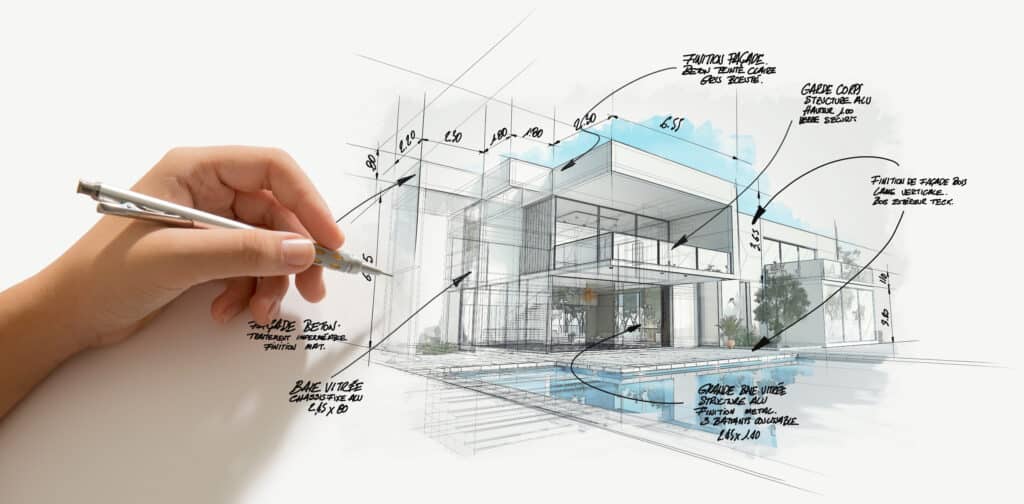Comprehending the Diverse Profession Paths Available for Aspiring Architect
As a hopeful Architect, you have a globe of occupation paths waiting for you. Each course provides distinct difficulties and possibilities to use your creativity and technical expertise. Whether you're attracted to traditional design or the nuances of sustainable layout, there's a specific niche that aligns with your interests. Comprehending these varied alternatives can form your expert journey, however which direction will you pick to explore initially?
Typical Style: Designing Structures and buildings
Standard architecture focuses on designing structures and frameworks that mix capability with visual appeal. Your layouts can reflect social heritage, showcasing regional traditions while meeting modern-day demands.
You'll develop skills in composing, model-making, and website evaluation, permitting you to visualize and interact your concepts properly. Involving with customers, you'll require to comprehend their vision and translate it right into viable styles.
Moreover, developing codes and sustainability practices are vital in your work, guaranteeing your frameworks are eco friendly and secure. As you expand in your occupation, you'll discover chances in domestic, industrial, or perhaps repair tasks, each offering one-of-a-kind difficulties. Embracing traditional style leads the way for a meeting career that pays tribute to the past while shaping the future.
Urban Planning: Forming Neighborhoods and Public Spaces
As an aspiring Architect, you can play a vital duty as a metropolitan planner, transforming just how areas engage and operate. By utilizing community involvement techniques, you'll ensure that residents have a voice fit their setting. Plus, incorporating lasting style principles will certainly help produce rooms that not just satisfy today's requirements but additionally protect the future.
Duty of Urban Planners
While lots of could assume of engineers as the single enthusiasts behind structures, metropolitan coordinators play an essential function in forming the wider landscape of communities and public areas. By working together with numerous stakeholders, you'll help develop parks, transport systems, and household areas that advertise social interaction and availability. Your experience in spatial design and community characteristics enables you to imagine future development while maintaining social heritage.
Neighborhood Interaction Methods
Effective area interaction strategies are crucial for city coordinators to assure that the voices of residents are listened to and valued in the preparation process. To cultivate meaningful dialogue, you need to prioritize open online forums and workshops where area participants can express their ideas and problems. By actively paying attention and integrating responses, you'll produce spaces that show the community's needs, ultimately leading to even more effective and sustainable city settings.
Sustainable Layout Concepts
When making city spaces, integrating sustainable style concepts is vital for developing environments that flourish both environmentally and socially. Take into consideration integrating green rooms, like parks and gardens, to improve biodiversity and enhance air high quality.
Creating with water preservation in mind is likewise essential-- think about rainfall yards and permeable surfaces to take care of stormwater. Including community participants during the planning procedure guarantees that the rooms you produce meet their demands and urge social communication. By embracing these concepts, you'll add to dynamic, lasting urban landscapes that profit everyone.

Landscape Style: Producing Lasting Outdoor Atmospheres
As you discover landscape architecture, you'll find crucial design principles that produce useful and beautiful outside areas. Sustainable techniques play an important role in making sure these settings grow while reducing environmental effect. And also, you'll locate a selection of career opportunities that enable you to make a genuine distinction in exactly how individuals engage with nature.
Layout Concepts in Landscape
Recognizing layout concepts in landscape style is essential for creating sustainable outdoor atmospheres that balance with nature. You'll need to consider aspects like equilibrium, scale, and proportion to ensure your designs feel cohesive and inviting. Including indigenous plants not only improves biodiversity but also reduces water use, making your landscape durable. Believe about the circulation of area and exactly how people connect with it; paths and seating areas should welcome expedition and relaxation. Additionally, pay interest to seasonal modifications, creating with products that match the surroundings year-round (Architect). By prioritizing sustainability and aesthetic appeals, you can create outdoor areas that enrich the area and promote well-being. Welcoming these principles will certainly establish a strong structure for your job in landscape design.
Sustainable Practices Introduction
Lasting methods in landscape architecture not only concentrate on visual appeals yet additionally focus on eco-friendly health and wellness and source conservation. By integrating indigenous plants, you boost biodiversity and minimize the requirement for chemical plant foods and pesticides. Executing efficient watering systems helps save water and minimizes runoff, safeguarding nearby communities. You can make spaces that promote dirt health, such as exercising and using organic materials permaculture principles. In addition, integrating eco-friendly infrastructure, like rainfall yards and porous sidewalks, aids in stormwater management and decreases metropolitan warmth. You add to a much healthier earth and give spaces that promote community connection when you develop outdoor atmospheres with sustainability in mind. Ultimately, these methods assure your designs benefit both individuals and the setting for many years ahead.
Profession Opportunities Exploration
With a solid structure in lasting techniques, landscape style provides a variety of profession paths that enable you to make a significant effect on the setting. You can function as a landscape developer, developing cosmetically pleasing and practical outside spaces, or focus on environmental reconstruction, aiding to revitalize broken ecosystems. Urban planners typically work together with landscape designers to create green rooms in city setups, boosting city livability. If you're passionate about education, consider coming to be a landscape style teacher, inspiring future generations. Additionally, you may collaborate with nonprofits concentrated on ecological sustainability or participate in research to innovate new techniques. Each course not just shapes beautiful environments but likewise fosters a much healthier world for future generations.
Sustainable Layout: Concentrating on Eco-Friendly Practices
As you discover your career in architecture, accepting environment-friendly practices can establish you apart in an affordable field. Lasting design concentrates on developing buildings that decrease environmental impact while boosting resident wellness. By incorporating sustainable products, energy-efficient systems, and sustainable building methods, you'll add to a greener future.
Start by getting understanding of environment-friendly certifications like LEED or BREEAM, which can boost your qualifications. Consider how all-natural light, air flow, and thermal efficiency can optimize layout. Work together with engineers and environmental consultants to introduce services that decrease waste and conserve resources.
Don't fail to remember the relevance of community participation-- appealing local stakeholders can motivate styles that harmonize with the atmosphere. As clients significantly prioritize sustainability, your knowledge in eco-friendly techniques will not just bring in projects yet likewise accomplish your interest for responsible architecture. Welcome this essential aspect of the occupation, and watch your profession flourish.
Historic Preservation: Safeguarding and Bring Back Social Heritage
While you commence on your architectural journey, think about the vital function of historical preservation in preserving our social heritage. This field concentrates on the defense and restoration of considerable structures, sites, and structures that inform my site the stories of our past. By taking part in historic conservation, you'll help guard the building heritage that shapes community identity.
As a historic preservation Architect, you'll analyze historical significance and assess the condition of structures. You'll work closely with preservationists and historians to guarantee genuine restoration methods are utilized. This profession course permits you to mix creative thinking with research, enabling you to design remedies that appreciate initial materials and craftsmanship.
Your work not only adds to sustainability by recycling existing buildings but likewise fosters a sense of pride within neighborhoods. Embracing this path will certainly help you come to be a guardian of background, maintaining the stories and visual appeals that enrich our lives.
Interior Style: Enhancing Indoor Spaces
Historical conservation and interior style both share a dedication visit this page to improving the developed setting, however they focus on various aspects. While historical conservation highlights maintaining a framework's social and historic worth, indoor style absolutely nos in on optimizing interior spaces for performance and aesthetic appeals.
As an ambitious Architect, you'll discover that indoor design permits you to mix creativity with technological skills. You'll develop rooms that not just look good yet additionally advertise convenience and performance. This area includes recognizing how light, color, and materials interact within a space, influencing mood and usability.
You'll work with different jobs, from household homes to business workplaces, making sure that each setting meets the demands of its residents. By focusing on customer experience, you can change interiors right into motivating and practical rooms, making a substantial influence on just how individuals connect with their surroundings. Accept the opportunity to improve indoor environments and form the method people live and function.
Industrial Style: Merging Capability With Aesthetics
Commercial style plays an important duty in producing items that effortlessly mix looks with performance, guaranteeing that what you make use of everyday is not only aesthetically attractive but additionally functional. As an aspiring Architect, you might immerse on your own in this field, concentrating on developing everything from furnishings to consumer electronic devices. Your job entails understanding individual needs, materials, and producing processes, permitting you to create cutting-edge services that boost everyday experiences.
In industrial layout, you'll typically work together with online marketers, suppliers, and engineers, ensuring that your layouts are not just beautiful but additionally possible. This job path uses a vibrant setting where creativity fulfills practicality, making it a gratifying selection for architects interested in shaping the products of tomorrow.
Often Asked Questions
What Educational Qualifications Do I Required to End Up Being an Engineer?
To end up being a designer, you'll need an expert level in design, usually a Bachelor's or Master's. Additionally, you'll need to complete an internship and pass the Architect Registration Exam to exercise legally.
Are There Accreditation Needs for Various Building Occupation Paths?
Yes, there're certification needs for various building paths. Architect. You'll require to pass exams, complete teaching fellowships, and often go after specialized training, depending on your chosen emphasis, like landscape style, urban style, or historical preservation
What Software Program Skills Are Crucial for Designers Today?

How Can I Gain Practical Experience While Researching Design?
You can gain sensible experience by interning at architectural companies, getting involved in design competitors, offering for neighborhood tasks, or collaborating with classmates on real-world projects. These opportunities improve your skills and construct useful connections in the market.
What Job Opportunities Exist Outside Standard Design Firms?
You can explore different job chances outside traditional design companies, like urban preparation, interior decoration, landscape architecture, building administration, actual estate advancement, or also functions in sustainability consulting. Each offers special obstacles and benefits.
Whether you're attracted to traditional architecture or the nuances of sustainable design, there's a niche that lines up with your rate of interests.When making metropolitan spaces, integrating sustainable style concepts is vital for producing settings that grow both ecologically and socially.As you check out landscape design, you'll find important design concepts that produce practical and lovely exterior areas.Understanding design principles in landscape architecture is vital for producing lasting exterior settings that integrate with nature.In commercial layout, you'll usually team up with producers, engineers, and marketing professionals, making sure that your designs are not only beautiful yet likewise possible.